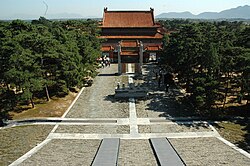Imperial tombs of the Ming and Qing dynasties
| Imperial tombs of the Ming and Qing dynasties 明清 皇家 陵寝 |
|
|---|---|
|
UNESCO world heritage |
|

|
|
| Qianlong's Mausoleum in Yuling |
|
| National territory: |
|
| Type: | Culture |
| Criteria : | (i), (ii), (iii), (iv), (vi) |
| Surface: | 3437.94 ha |
| Buffer zone: | 23,429.44 ha |
| Reference No .: | 1004 |
| UNESCO region : | Asia and Pacific |
| History of enrollment | |
| Enrollment: | 2000 (session 24) |
| Extension: | 2003, 2004 |
The imperial tombs of the Ming and Qing dynasties ( 明清 皇家 陵寢 / 明清 皇家 陵寝 , Míng qīng huángjiā língqǐn ) are several tombs of the emperors of China and their wives, which were built in the 15th to 18th centuries during the Ming dynasty (1368-1644) and Qing dynasty (1644-1911) emerged. The tombs are spread over several regions of China.
list
Tombs of the Ming and Qing dynasties (numbering according to the table) |
The world heritage includes the following 14 sites according to the numbering of UNESCO:
meaning
The graves are on the list of monuments of the People's Republic of China (see under the individual provinces) and on the list of UNESCO World Heritage .
UNESCO describes the importance of the graves with five criteria: the graves are a masterful example of the integration of architecture and natural surroundings according to the principles of Fengshui . They represent the further development of earlier art forms in the Ming and Qing times and are excellent evidence of a cultural and architectural tradition that has shaped this world region for over 500 years. The connection between architecture and nature forms a unique cultural landscape; the tombs illustrated the worldview, beliefs and geomantic principles of feudal China.
History of enrollment
On December 2, 2000, the first four above-mentioned graves were inscribed in the world heritage. On July 5, 2003, the Xiaoling Mausoleum from the Ming Dynasty (1004-005) and the graves of several imperial officials of the Ming Dynasty in Nanjing (1004-005 to 1004-011) were added to the World Heritage List. On July 7, 2004, three more tombs from the 17th century in Liaoning Province ( Yongling Mausoleum , Fuling Mausoleum , Zhaoling Mausoleum ) were added to the World Heritage Complex (1004-012 to 1004-014).
Web links
- Imperial Tombs of the Ming and Qing Dynasties on the UNESCO World Heritage Center website ( English and French ).
Individual evidence
- ^ Imperial Tombs of the Ming and Qing Dynasties: Multiple Locations (14). UNESCO website, accessed January 3, 2019 .
- ↑ a b c UNESCO World Heritage Center: Imperial Tombs of the Ming and Qing Dynasties. Retrieved March 30, 2017 (English).

